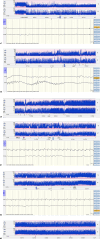Efficacy of Levetiracetam as Add-On Therapy in the Treatment of Seizures in Neonates
- PMID: 38113859
- PMCID: PMC10994567
- DOI: 10.1159/000535499
Efficacy of Levetiracetam as Add-On Therapy in the Treatment of Seizures in Neonates
Abstract
Introduction: There is no consensus regarding the efficacy of add-on therapy with levetiracetam (LEV) in the treatment of seizures in neonates. The aim of this study was to evaluate the efficacy of add-on therapy with LEV for achieving >80% seizure reduction after phenobarbital (PB) treatment.
Methods: Retrospective cohort study of near term neonates admitted to the neonatal intensive care unit with EEG-confirmed seizures despite treatment with PB as first-line therapy and using LEV as 2nd-, 3rd- or 4th-line treatment. Antiseizure medication was administered according to national guidelines. All neonates were monitored with 2-channel amplitude-integrated electroencephalography. The total seizure burden in minutes, 2 h before and 4 h after administration of LEV, was calculated using raw EEG. Primary outcome was the efficacy of LEV in achieving >80% seizure reduction. The efficacy of additional midazolam (MDZ) and lidocaine (LDC) was also calculated.
Results: A total of 47 full-term neonates were included. The mean total loading dose of LEV was 40 mg/kg (36-44 mg/kg). Seizure etiology consisted of hypoxic-ischemic encephalopathy (n = 11), hemorrhagic or ischemic stroke (n = 16), central nervous system infection (n = 8), genetic (n = 8), metabolic disorders (n = 3), and unknown (n = 1). Following LEV administration, >80% seizure reduction was observed in 17% (8/47) of neonates, whereas it was 23% (6/26) after MDZ and 92% (23/25) after LDC administration.
Discussion: Although the cumulative loading dose of LEV was low and the group of infants studied was heterogeneous, the efficacy of LEV as add-on therapy for the treatment of seizures in neonates was limited. The highest seizure reduction rate was seen after LDC administration.
Keywords: Amplitude-integrated electroencephalography; Antiseizure medication; Levetiracetam; Lidocaine; Midazolam; Seizure reduction; Seizures in neonates.
© 2023 The Author(s). Published by S. Karger AG, Basel.
Conflict of interest statement
The author(s) declared no potential conflicts of interest with respect to the research, authorship, and/or publication of this article.
Figures



References
-
- Vasudevan C, Levene M. Epidemiology and aetiology of neonatal seizures. Semin Fetal Neonatal Med. 2013;18(4):185–91. - PubMed
-
- Roubertie A, Masson F, de Villepin-Touzery A, Suau B, Barbanel G, Rideau A, et al. . Neonatal seizures management. Arch Pediatr. 2011;18(Suppl 2):56–64. - PubMed
-
- Plouin P, Kaminska A. Neonatal seizures. Handb Clin Neurol. 2013;111:467–76. - PubMed
MeSH terms
Substances
LinkOut - more resources
Full Text Sources
Medical
Miscellaneous

